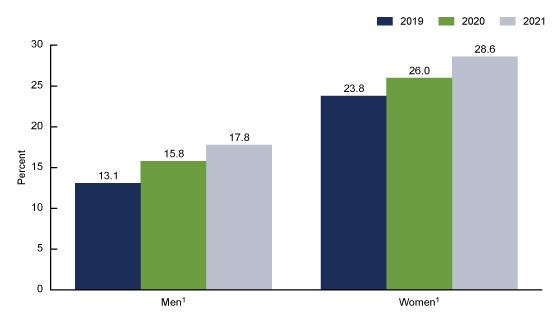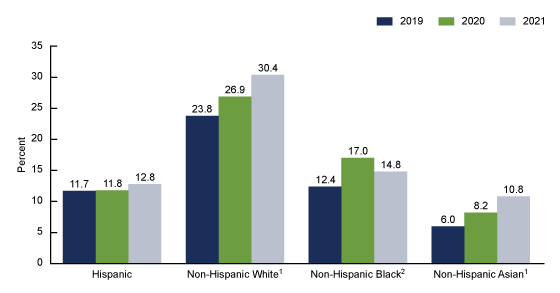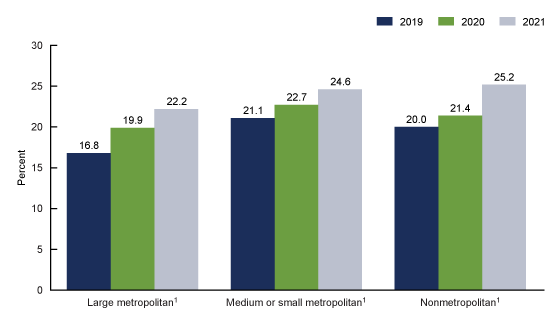Mental Health Treatment Among Adults Aged 18–44: United States, 2019–2021
NCHS Data Brief No. 444, September 2022
PDF Version (485 KB)
Emily P. Terlizzi, M.P.H., and Jeannine S. Schiller, M.P.H.
- Key findings
- The percentage of adults who had received any mental health treatment increased between 2019 and 2021.
- Among adults aged 18–44, both men and women were more likely to have received any mental health treatment in 2021 compared with 2019.
- The trend in the percentage of adults aged 18–44 who had received any mental health treatment varied by race and Hispanic origin.
- From 2019 to 2021, the percentage of adults aged 18–44 who had received any mental health treatment in the past 12 months increased regardless of urbanization level.
Data from the National Health Interview Survey
- The percentage of adults who had received any mental health treatment in the past 12 months increased from 2019 to 2021, among both adults of all ages (from 19.2% to 21.6%) and those aged 18–44 (from 18.5% to 23.2%).
- Among adults aged 18–44, women were more likely than men to have received any mental health treatment.
- From 2019 to 2021, the percentage of adults aged 18–44 who had received any mental health treatment increased among non-Hispanic White (from 23.8% to 30.4%) and non-Hispanic Asian (from 6.0% to 10.8%) adults.
- Among adults aged 18–44, the percentage who had received any mental health treatment increased from 2019 to 2021 across large and medium or small metropolitan and nonmetropolitan areas.
In 2020, the percentage of adults who had received any mental health treatment in the past 12 months was significantly higher than in 2019 (1, 2). Previous research has found that symptoms of an anxiety disorder or a depressive disorder increased from 2020 through the beginning of 2021, especially among younger adults (3). This report describes trends in the percentage of adults aged 18–44 who had received any mental health treatment, defined as having either taken medication for mental health, received counseling or therapy, or both in the past 12 months by selected characteristics based on data from the 2019–2021 National Health Interview Survey (NHIS). Estimates for adults aged 45–64 and 65 and over are presented for comparison.
Keywords: medication, counseling, therapy, National Health Interview Survey
The percentage of adults who had received any mental health treatment increased between 2019 and 2021.
- From 2019 to 2021, the percentage of adults who had received any mental health treatment increased from 19.2% to 21.6% (Figure 1).
- The percentage of adults who had received any mental health treatment in the past 12 months increased between 2019 and 2021 among adults aged 18–44, from 18.5% to 23.2%.
- Among adults aged 45–64 and 65 and over, the percentage who had received any mental health treatment did not change significantly during this time period.
- In 2021, the percentage of adults who had received any mental health treatment was highest among those aged 18–44 (23.2%), followed by adults aged 45–64 (21.2%) and those aged 65 and over (18.9%).
Figure 1. Percentage of adults aged 18 and over who had received any treatment for their mental health in the past 12 months, by age group and year: United States, 2019–2021

1Significant linear trend by year (p < 0.05).
NOTES: Adults were considered to have received any treatment for their mental health if they reported taking prescription medication for their mental health, receiving counseling or therapy from a mental health professional, or both in the past 12 months. Adults were asked separately if they took medication for feelings of anxiety, for feelings of depression, or to help with any other emotions or with their concentration, behavior, or mental health. Adults who responded yes to any of these questions were considered to have taken prescription medication for their mental health in the past 12 months. Estimates are based on household interviews of a sample of the civilian noninstitutionalized population. Access data table for Figure 1.
SOURCE: National Center for Health Statistics, National Health Interview Survey, 2019–2021.
Among adults aged 18–44, both men and women were more likely to have received any mental health treatment in 2021 compared with 2019.
- From 2019 to 2021, the percentages of men (from 13.1% to 17.8%) and women (from 23.8% to 28.6%) aged 18–44 who had received any mental health treatment in the past 12 months increased (Figure 2).
- For each year, women were more likely than men to have received any mental health treatment.
Figure 2. Percentage of adults aged 18–44 who had received any treatment for their mental health in the past 12 months, by sex and year: United States, 2019–2021

1Significant linear trend by year (p < 0.05).
NOTES: Adults were considered to have received any treatment for their mental health if they reported taking prescription medication for their mental health, receiving counseling or therapy from a mental health professional, or both in the past 12 months. Adults were asked separately if they took medication for feelings of anxiety, for feelings of depression, or to help with any other emotions or with their concentration, behavior, or mental health. Adults who responded yes to any of these questions were considered to have taken prescription medication for their mental health in the past 12 months. Estimates are based on household interviews of a sample of the civilian noninstitutionalized population. Access data table for Figure 2.
SOURCE: National Center for Health Statistics, National Health Interview Survey, 2019–2021.
The trend in the percentage of adults aged 18–44 who had received any mental health treatment varied by race and Hispanic origin.
- From 2019 to 2021, the percentage of adults who had received any mental health treatment in the past 12 months increased among non-Hispanic White (from 23.8% to 30.4%) and non-Hispanic Asian (from 6.0% to 10.8%) adults aged 18–44 (Figure 3).
- The percentage of non-Hispanic Black adults who had received any mental health treatment was lower in 2019 (12.4%) than in 2020 (17.0%) and 2021 (14.8%).
- For each year, non-Hispanic White adults were the most likely to have received any mental health treatment.
- For each year, non-Hispanic Black adults were more likely to have received mental health treatment in the past 12 months than non-Hispanic Asian adults.
Figure 3. Percentage of adults aged 18–44 who had received any treatment for their mental health in the past 12 months, by race and Hispanic origin and year: United States, 2019–2021

1Significant linear trend by year (p < 0.05).
2Significant quadratic trend by year (p < 0.05).
NOTES: Adults were considered to have received any treatment for their mental health if they reported taking prescription medication for their mental health, receiving counseling or therapy from a mental health professional, or both in the past 12 months. Adults were asked separately if they took medication for feelings of anxiety, for feelings of depression, or to help with any other emotions or with their concentration, behavior, or mental health. Adults who responded yes to any of these questions were considered to have taken prescription medication for their mental health in the past 12 months. Adults categorized as Hispanic may be of any race or combination of races. Adults categorized as non-Hispanic White, non-Hispanic Black, or non-Hispanic Asian indicated one race only. Estimates are based on household interviews of a sample of the civilian noninstitutionalized population. Access data table for Figure 3.
SOURCE: National Center for Health Statistics, National Health Interview Survey, 2019–2021.
From 2019 to 2021, the percentage of adults aged 18–44 who had received any mental health treatment in the past 12 months increased regardless of urbanization level.
- The percentage of adults aged 18–44 who had received mental health treatment in the past 12 months increased from 2019 to 2021 among those living in large metropolitan areas (from 16.8% to 22.2%), medium or small metropolitan areas (from 21.1% to 24.6%), and nonmetropolitan areas (from 20.0% to 25.2%) (Figure 4).
- In 2021, the percentage of adults aged 18–44 who had received mental health treatment was highest among those living in nonmetropolitan areas; however, the differences among the three urbanization level groups were not significant.
Figure 4. Percentage of adults aged 18–44 who had received any treatment for their mental health in the past 12 months, by urbanization level and year: United States, 2019–2021
1Significant linear trend by year (p < 0.05).
NOTES: Adults were considered to have received any treatment for their mental health if they reported taking prescription medication for their mental health, receiving counseling or therapy from a mental health professional, or both in the past 12 months. Adults were asked separately if they took medication for feelings of anxiety, for feelings of depression, or to help with any other emotions or with their concentration, behavior, or mental health. Adults who responded yes to any of these questions were considered to have taken prescription medication for their mental health in the past 12 months. Estimates are based on household interviews of a sample of the civilian noninstitutionalized population. Access data table for Figure 4.
SOURCE: National Center for Health Statistics, National Health Interview Survey, 2019–2021.
Summary
The percentage of U.S. adults who had received any mental health treatment in the past 12 months increased from 2019 to 2021, driven largely by a nearly 5 percentage point increase among adults aged 18–44. In 2021, nearly 1 in 4 adults aged 18–44 (23.2%) received treatment. Among adults aged 18–44, the receipt of mental health treatment increased over time for both men and women, for both non-Hispanic White and non-Hispanic Asian adults, and across metropolitan and nonmetropolitan areas. Estimates in 2021 for adults aged 18–44 were highest among women (28.6%) and non-Hispanic White adults (30.4%).
Definitions
Any mental health treatment, past 12 months: Adults were asked separately if they took prescription medication for feelings of anxiety, for feelings of depression, or to help with any other emotions or with their concentration, behavior, or mental health. Those who responded yes to any of these questions were considered to have taken medication for their mental health in the past 12 months. Adults were considered to have received any mental health treatment in the past 12 months if they reported either receiving counseling or therapy from a mental health professional or having taken medication for their mental health in the past 12 months.
Race and Hispanic origin: Adults categorized as Hispanic may be of any race or combination of races. Adults categorized as non-Hispanic White, non-Hispanic Black, and non-Hispanic Asian indicated one race only.
Urbanization level: Metropolitan size and status was determined using the 2013 National Center for Health Statistics (NCHS) urban–rural classification scheme for counties (4) by merging the geographic federal information processing standard (FIPS) codes for the county of household residence with the county-level FIPS codes from the classification scheme’s data set. Large metropolitan includes large central and large fringe metropolitan counties. Medium or small metropolitan includes medium and small metropolitan counties. Nonmetropolitan includes micropolitan and noncore counties.
Data source and methods
Data from the 2019–2021 NHIS were used for this analysis. NHIS is a nationally representative household survey of the U.S. civilian noninstitutionalized population. It is conducted continuously throughout the year by NCHS. Interviews are typically conducted in respondents’ homes, but follow-ups to complete interviews may be conducted over the telephone. Due to the COVID-19 pandemic, NHIS data collection switched to a telephone-only mode beginning on March 19, 2020. Personal visits to households resumed in selected areas in July 2020 and in all areas of the country in September 2020. However, interviews were still attempted by telephone first, and most were completed by telephone. The “telephone first” data collection approach that began in July 2020 continued through April 2021. Starting in May 2021, U.S. Census Bureau field representatives were given discretion based on their own health risk and the conditions in the area to resume personal visits. For more information about NHIS, visit: https://www.cdc.gov/nchs/nhis.htm.
Point estimates and the corresponding confidence intervals for this analysis were calculated using SAS-callable SUDAAN software (5) to account for the complex sample design of NHIS. Differences between percentages were evaluated using two-sided significance tests at the 0.05 level. Trends by year, age group, and urbanization level were evaluated using orthogonal polynomials in logistic regression. All estimates meet NCHS data presentation standards for proportions (6).
About the authors
Emily P. Terlizzi and Jeannine S. Schiller are with the National Center for Health Statistics, Division of Health Interview Statistics.
References
- Terlizzi EP, Norris T. Mental health treatment among adults: United States, 2020. NCHS Data Brief, no 419. Hyattsville, MD: National Center for Health Statistics. 2021. DOI: https://dx.doi.org/10.15620/cdc:110593.
- QuickStats: Percentage of adults who received any mental health treatment in the past 12 months, by age group and year—National Health Interview Survey, United States, 2019–2020. MMWR Morb Mortal Wkly Rep 70(43):1525. 2021.
- Vahratian A, Blumberg SJ, Terlizzi EP, Schiller JS. Symptoms of anxiety or depressive disorder and use of mental health care among adults during the COVID-19 pandemic—United States, August 2020–February 2021. MMWR Morb Mortal Wkly Rep 70(13):490–4. 2021.
- Ingram DD, Franco SJ. 2013 NCHS urban–rural classification scheme for counties. National Center for Health Statistics. Vital Health Stat 2(166). 2014.
- RTI International. SUDAAN (Release 11.0.3) [computer software]. 2018.
- Parker JD, Talih M, Malec DJ, Beresovsky V, Carroll M, Gonzalez JF Jr, et al. National Center for Health Statistics data presentation standards for proportions. National Center for Health Statistics. Vital Health Stat 2(175). 2017.
Suggested citation
Terlizzi EP, Schiller JS. Mental health treatment among adults aged 18–44: United States, 2019–2021. NCHS Data Brief, no 444. Hyattsville, MD: National Center for Health Statistics. 2022. DOI: https://dx.doi.org/10.15620/cdc:120293.
Copyright information
All material appearing in this report is in the public domain and may be reproduced or copied without permission; citation as to source, however, is appreciated.
National Center for Health Statistics
Brian C. Moyer, Ph.D., Director
Amy M. Branum, Ph.D., Associate Director for Science
Division of Health Interview Statistics
Stephen J. Blumberg, Ph.D., Director
Anjel Vahratian, Ph.D., M.P.H., Associate Director for Science
